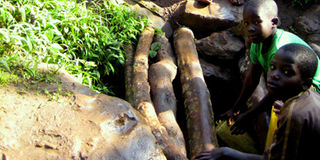The long journey to quenching thirst in namayingo island

Namayingo water is not only hard to access but also salty. Photo by Veronica Kagona
What you need to know:
While most of the country is enjoying safe drinking water, residents of Namayingo are still grappling with access to it.
Just two years ago, Namayingo had no access to safe drinking water. A few bore holes scattered between villages, some water tanks here and there and that was pretty much what Namayingo could show for safe drinking water. This, with alarming figures as low as 32 per cent of the population having access to safe water. Lake Victoria was the only public water source, for drinking, cleaning utensils, washing clothes, bathing as well as watering animals.
According to Connie Anastasia Ndira, the island’s representative to the district council, “Water in Namayingo is salty. This unsafe water has led to death of many people.”
Globally, more than 1.1 billion people, 20 per cent of the world’s population, lack access to safe water. Every year, 1.6 million people die from diarrhoeal diseases (including cholera and intestinal helminthes like hook worms), 90 per cent of whom are children under five.
All these are attributable to lack of access to safe drinking water and basic sanitation.
And this is why Water Missions Uganda (WMU) identified Namayingo as a priority area in its fight to improve drinking water and sanitation in Uganda.
WMU is a water-engineering organisation that aims to provide sustainable safe water solutions to communities in country. An affiliate of WMI, which started operating in Uganda in 2007. They moved into the district, and set up two safe water projects at Busiiro in Banda sub-county and Maruba in Mutumba sub-county.
They started with assessing the water needs of the communities and actively mobilising the community and conducting water, sanitation and hygiene promotion as part of social marketing. They also trained the community to run the project as a micro-enterprise.
Then they set out to provide sustainable access to safe water and sanitation to the residents of the communities where they operated, along the same modes of operation they have used in 61 projects to serve over 100,000 people in the eight districts of Uganda.
Since then, they have provided three innovative solutions complementing their provision of safe water and sanitation to communities. One of the ways they do this is by using the StandAlone Chlorinator solution which disinfects contaminated water with the help of chlorine and treats up to 75.7 litres per minute. It can easily be installed in both community development and disaster settings.
Electronic access to water
Water is sold through an electronically monitored water unit, making sales fully accountable. Water users draw or access safe water through an electronically monitored water unit using a “User Water Key”.
Residents use cash to buy credit from the Water Agent, who transfers credit from his or her Water Agent Key to their User Water Key. Simon Peter Baraza in charge of Maruba safe water project says, “This has been of help to the community for it has generated supplementary funds to pay for ongoing costs associated with damage to the community water system. Currently we have Shs4m on our account.”
The project was designed to be run by the community. This solution employs an indigenous person to take care of management of the operation, maintenance and the business aspects of the project, as well as making it an integral part of the community, ensuring long-term sustainability without incurring additional costs to operate it.
In Maruba, Baraza manages the project with the assistance of the water users’ committee.
“Our project sustainability rate is over 95 per cent,” says Michael Bazira, the country director of WMU.
He proudly declares that the WMU focuses on quality services in the safe water sector. It has already established safe water projects in Mayuge, Mukono, Buikwe, Jinja, Bugiri, Namayingo, Mbarara, Bushenyi, and on landing sites as well as refugee centres in Rwamwanja since it started operations in the country seven years ago.
A visit to Namayingo reveals the benefits to the society. WMU provides a source of income for water tap attendants and local system operators who earn a commission on water proceedings. Where 60 per cent of rural households had walked for at least 1.5 km to fetch water, today they save time for other productive activities which include going to school.
According to Patrick Odinga Onyango, the LC I chairperson, Maganiro West, the project is running smoothly except when the weather conditions change and interfere with the water processing.
Also, the operation has faced several challenges which are mainly operational and financial.
“We have experienced mishandling of operation and maintenance funds by the local leadership of water users committees in some communities,” says Bazira.
In response, WMU has strengthened bylaws at the community level, introduced a transparent automated water unit dispenser that can track all water dispensed and the cash received. In cases of failure of the solar system, they improvise with a generator. Bazira says that WMU hopes to help halve the proportion of people without access to clean drinking water or sanitation by 2015.
“WMU can attain a 70 per cent reduction in the proportion of people without access to safe water by 2015.” WMU now plans to cover Masindi, Pallisa and Kamwenge.




